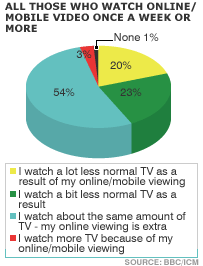I ordinarily don’t post virals like this, but seeing as though I mentioned that all my contemporaries want a PS3, I guess they (and I!) have to come to grips with what that might mean.
Mildly, mildly NSFW.

I ordinarily don’t post virals like this, but seeing as though I mentioned that all my contemporaries want a PS3, I guess they (and I!) have to come to grips with what that might mean.
Mildly, mildly NSFW.
The BBC listed their sources, gave us the sampling methodology, and drew us some pietastic metrics.
But pie charts and surveys are not very good at illustrating qualitative responses.
Take this one:

But where is the “I downloaded all the stuff I wanted to see, so I watched less real actual TV” or “Four hours on YouTube left me with one hour of BBC3 before gran told me to go to bed”? Under the label “normal TV”.
The venerable Beeb trudged on with their second tasty pie graphic:
[Part 2 of a brainstorm. Part 1 also available]
Dion Hinchcliffe uses the word “monetize” [sic], but the principle is the same. Compare folio the diagram in Part 1.
But the biggest question that comes up is that if you let your users generate most of your content and then expose it all up via an API, how can a profitable business be made from this?
His thesis is to examine methods to go far beyond advertising, subscriptions, and commissions. The bullet points below have been abbreviated for readability.
Some of the indirect ways which lead to revenue growth, user growth, and increased resistance to competition […] are:
- Strategic Acquisition
- Maintaining control of hard to recreate data sources.
- Building Attention Trust
- Turning Applications into Platforms
- Fully Automated Online Customer Self-Service
The article is a comprehensive read, and acknowledges pro and con viewpoints for each opportunity,
While a great many startups are not generating revenue in huge quantities yet, the companies that have been diligently exploiting open APIs such as Amazon and Salesforce are in fact generating significant revenue and second order effects from opening up their platforms and being careful not to lose control. This is actually a large discussion, and as large Web 2.0 sites continue to emerge, we’ll continue to keep track of what the successful patterns and practices are.
Thus we are left with questions. Always more questions.
The one that concludes this brainstorm is:
What other implications are there by putting users in control of content generation and open everything up?
How would you advise a client on the best way to drive participation in one shaded ball towards revenues from another?
I can’t see a clear path forward, as you can’t make a consumer do something; one can suggest and imply a desired action, or one can induce behaviours. You can also create desire for something seemingly unattainable.
But forcibly obliging a customerbase to perform an action? That’s performing-animal territory.
Or is that capitalist monopolism?
It’s not particularly new, but this mayhem-on-the-track Machinima was a serendipitous discovery while I was looking at this flickr image.